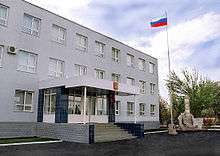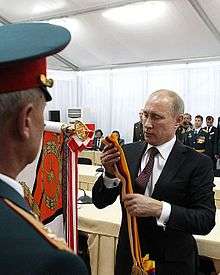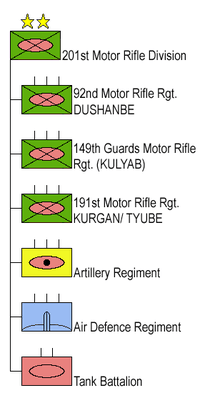Russian 201st Military Base
The Russian 201st Military Base (Tajik: Пойгоҳи низомии 201-и Русия; Russian: 102-я российская военная база) is a Russian military base based in Dushanbe, Tajikistan, part of the Central Military District. It was originally raised twice in World War II as part of the Soviet Union's Red Army and is now part of the Russian Ground Forces.

| 201st Rifle Division (I Formation) 1941–1942 (converted to 43rd Guards Rifle Division) 201st Rifle Division (II Formation) 1943 – c. 1945 325th Rifle Brigade c. 1945 – 1948 27th Mountain Rifle Division 1948–1957 124th Motor Rifle Division 1957–1965 201st Motor Rifle Division 1965–2004 201st Military Base (2004–present) | |
|---|---|
 Gate of 201st Military Base, Tajikistan | |
| Active | 1941–present |
| Country | |
| Branch | |
| Type | Military base |
| Role | Security |
| Part of | Central Military District |
| Garrison/HQ | Dushanbe |
| Engagements | Battle of Moscow, Siege of Leningrad, Gatchina, Luga, Narva, Riga, Courland, Soviet–Afghan War |
The Great Patriotic War
201st Rifle Division (first formation)
The division was formed as Red Army national unit on 3 August 1941 in Gorokhovets, Vladimir Oblast, Moscow Military District from remains of the 24th Territorial Rifle Corps. It was originally designated as the 201st Latvian Rifle Division, the first of three national divisions with predominantly Baltic-speaking personnel.[1] The basis of the division was the 76th Independent Latvian Rifle Regiment which was in turn formed from the two Latvian volunteer battalions that participated in the retreats of the Red Army, including the defence of Tallinn. It had been established in August 1941 at Gorki (today Nizhny Novgorod) Gorokhovetz Army Camp. In addition to the much depleted 76th regiment (about 1200 troops), were added 2500 Latvian speaking members of the state militia (police) and NKVD, as well as the predominantly Latvian speaking 582nd Construction Battalion, and members of the 24th Corps which was the territorial reserve formation in Latvia which failed to form due to rapid German advance.
At this time the composition of the division included the 92nd, 122nd and 191st Rifle Regiments, 220th Artillery Regiment, 10th Independent AAA Battery, 170th Independent Signals Battalion, and other support units. By December 1941 the division had 10,348 personnel, of whom 51% were ethnic Latvians, 26% ethnic Russians, 17% Jews and 6% others. This caused some problems since most Jews spoke Yiddish only, and the Latvians published the divisional paper Latvijas strēlnieks (Latvian Rifleman) in Latvian. At least 70 Jewish members of the division were members of the Zionist Beitar organisation that had been training members for travel to the then Palestine to defend Jewish settlements there before Latvia was annexed by Soviet Union.
The first combat the division experienced was during the counter-offensive at Moscow in the areas of Naro-Fominsk and Borovsk where it suffered 55% casualties. By June 1942 only 36% of the division were Latvian-speaking, and a year later this figure was reduced to 32%. However, in part this was due to the formation of a second Latvian division, the 308th Latvian Rifle Division. The division was reflagged as the 43rd Guards Rifle Division in October 1942.
The division joined in combat for Moscow (from 20 December 1941 until 20 January 1942), for Staraya Russa (from 16 February 1942 until 4 April), Demjansk bridgehead (from 6 April 1942 until 9 April 1943; see also Demyansk Shield); from 10 April 1943 until 15 October the division was in Staraya Russa region, from 18 October 1943 until 26 June 1944 in Velikiye Luki and Novorzhev region. From 26 June 1944 until 11 July the division was included with the 130th Latvian Riflemen Corps until crossing the Latvian border (22nd Army). From 18 July 1944 Šķaune region and joined combat on Latvian soil on 7 November 1944.[2]
The division also included other Latvian citizens who were behind the Soviet front line and a large number of Russia's Latvians. Beginning strength was about 2,100 men. In September 1941 the division had about 10,000 men. The division contained the 92nd, 122nd and 191st Rifle Regiments and 220th Artillery Regiment. On 5 October 1942 it became the 43rd Latvian Guard Riflemen Division. Regiments assigned to this Division were the 121st, 123rd, and 125th Guard Rifle Regiments and the 94th Guard Artillery Regiment, the 270th Artillery Battalion which was renamed to the 55th Guard Artillery Battalion, the 48th Guard Antitank Artillery Battalion, the 100th Antiaircraft Battery which was renamed to the 44th Guard Antiaircraft Battery, the 53rd Sapper Battalion which was renamed to the 47th Guard Sapper Battalion. The division was commanded by Guard Major General Jānis Veikins, Regiment Commander L. Paegle, Regiment Commander A. Frolovs, Guard Major General Detlavs Brantkalns and Alfrēds Kalniņš.[3]
201st division (2nd formation)
A new division was raised for the second time from the 27th Rifle Brigade at Shlisselburg, near Leningrad, in November 1943 within the 23rd Army. It served in the Leningrad and Baltic coast areas. Aside from the usual components of the rifle division in 1943, the division also had a separate battalion equipped with snow skis, and each regiment had a snow ski equipped company to serve as advance detachments. In September the division was transferred to the 3rd Army. The initial composition of the division included:
- 92nd Rifle Regiment (former 3rd, 5th, 33rd and 102nd Border Guard detachments from the Karelian peninsula Border Guard Brigade)
- 122nd Rifle Regiment (former 13th Leningrad Internal Security Brigade)
- 191st Rifle Regiment (was created from detachments of a naval infantry brigade of the Baltic Fleet)
- 220th Artillery Regiment
- 256th Separate Communications Battalion
- 119th Separate Reconnaissance Company
- 122nd Separate Reconnaissance Company(ski)
- 198th Separate Anti-Tank Division
- 51st Separate Sapper Battalion
- 53rd Separate Sapper Battalion
- 49th Separate Medical-Sanitary Battalion
- 20th Separate Auto-Delivery Company
- 136th Separate Chemical Company
The division's first commander was Colonel Vyacheslav Petrovich Yakutovich.
In January 1944 the division was assigned to the 122nd Rifle Corps. The division received the title Gatchina for its role in breaking the siege of Leningrad and received its first Order of the Red Banner during the war. Following the relief of the siege the division incorporated several partisan detachments and groups which were used to strengthen the reconnaissance and ski equipped units. In February the division was transferred to the 117th Rifle Corps, and soon after was awarded the Order of the Red Banner for the liberation of Luga.
In June 1944 the division was serving with the 8th Army before moving to participate in the assault on Narva, for which the 191st regiment was awarded the honorific Narvsky. On 5 August 1944 the division was transferred to the 2nd Shock Army, and participated in the battles to break the Panther Line, after which it was withdrawn for a brief reconstitution, and a movement by train to the Pskov area of operations with the rest of the army. During the further battles in the Baltic republics the 191st Rifle Regiment was awarded the Order of Alexander Nevsky for destroying the German 23rd Infantry Regiment (12th Infantry Division) and two Latvian SS battalions. In the process of these battles the 1st and 2nd Battalions of the regiment at one time were reduced to 20–30 men while the 3rd Battalion ceased to exist. In October 1944 the division participated in the liberation of Riga after which the division was transferred to the 1st Baltic Front and participated in the containment of the Courland encirclement of Wehrmacht forces. From March 1945 the division was in the 1st Rifle Corps of the 1st Shock Army of the Kurland Group (Leningrad Front). On 1 October 1945 the division completed its movement to Dushanbe in Tajikistan.
Cold War and post-independence
Post-war
Following post-war reductions the division was reflagged as the 325th Rifle Brigade, but in 1948 was again reflagged as a 27th Mountain Rifle Division. This included receiving pack mountain 75mm guns for its artillery regiment that were of the 1905 model with their manufacturer's plate stating they were manufactured in St. Petersburg. In 1958, following post-Stalinist reforms, the division was reduced to the 451st Mountain Rifle Regiment, but in the next year it was reformed albeit as the 124th Motor Rifle Division (cadre, about fifteen per cent strong),[4] including the 401st Tank Regiment. It reverted to the 201st Gatchina Motor Rifle Division in 1965. By this time the division's artillery regiment became the 998th Self Propelled Artillery Regiment Starokonstantinovsky. In 1960s the division also received the 1098th Anti-Aircraft Missile Regiment.
The first military parade in Stalinabad took place with the participation of the 201st Motor Rifle Division took place on 7 November 1945.[5][6][7]
Afghanistan
As part of the Central Asian Military District, the division participated in the invasion of Afghanistan in December 1979, when it entered Afghanistan with the 40th Army. It was stationed in Kunduz province. At this time the division lost the 92nd and 191st Motor Rifle Regiments, and gained the 149th Guards Chenstokhova Motor Rifle Regiment and the 395th Motor Rifle Regiment. The division headquarters, the 220th Artillery Regiment, 149th Guards and other smaller units were stationed in Kunduz, while the 122nd MRR was based in Tashkurgan and the 395th MRR in Puli-Khumri. The tank regiment remained in Samarkand.
During its service in Afghanistan the division largely coordinated its operations with the Afghan Army's 18th (Mazar-i-Sharif) and 20th (Baglan) Infantry Divisions, as well as the 10th and 31st Infantry Regiments.
In 1985, the division received a second Order of the Red Banner. The division used BMP-1 and BMP-2 infantry fighting vehicles, BTR-60 and BTR-70 armoured personnel carriers, T-62 tanks and Gvozdika 122mm self-propelled guns. The last Soviet vehicle to leave Afghanistan on 15 February 1989 was a BTR-60 from the 201st. The BTR-60 is still kept to the present day as a memorial.
Following its withdrawal, the 191st MRR was returned to the division, while it retained the 149th Guards MRR.
The Tajik Civil War
At the time the Soviet Union collapsed in 1991, the 201st was stationed in Tajikistan. Newly independent Tajikistan fell apart in 1992 – the Tajikistan Civil War. Most of the conscripts were raised in Tajikistan and deserted while the Russian officers kept control of the division’s equipment after its subunits were reinforced with Russian spetsnaz troops. In September 1992, Russian President Yeltsin reinstated the division under firm Russian control. The CIS formed the Collective Peacekeeping Force in Tajikistan, and the 201st formed its core.
The 201st Motor Rifle Division, with the support of loyal Tajik forces, attacked Dushanbe. Russian and Tajik force entered and seized control of the city in December 1992. After the capital was recaptured, offensives were launched in Kofarnikhon and Kurgan-Tyube. Both cities fell quickly and the major concentrations of Islamist rebels were scattered. However, in 1995, Islamist insurgents assaulted one of the bases of the 201st in Gorno-Badakhshan Autonomous Region and ambushed a convoy near Kalashum, 200 km east of Dushanbe. The division launched a counterattack supported by ground attack aircraft and attack helicopters. On April 19, the 201st launched an offensive into Gorno-Badach and advanced 20 kilometres, forcing the Islamists out of several bases.
In 1996 the division's sapper battalion participated in border region mine clearance operations with Tajikistan forces.
In 2001 the division was deployed to the Afghanistan border in expectation of the US attack on Afghanistan, and possible attempts by the Taliban to cross the border into Tajikistan.
From 2003 onwards



On 13 August 2003 the 201st Motor Rifle Division participated in a joint exercise with the Tajik military 10 km southwest of Dushanbe at the Lyaur testing ground.
At one point during the civil war in Tajikistan, soldiers of the 201st Motor Rifle Division safely escorted staff of the US Embassy in Dushanbe to the airport for evacuation. This marks the only time in history that Americans have officially asked for and been given protection by the Russian military.
In October 2004, it was renamed the 201st Military Base.[4] In October 2012, it was signed an agreement extending the term of deployment of the Russian military base in Tajikistan until 2042.[8] Within the planned rearmament, about 100 units of new equipment, mostly the BTR-82A armored personnel carriers, as well as more than 10 T-72B1 tanks, have been delivered to the 201st military base in 2016, as well as a Borisoglebsk-2 EW system and a Garmony air defence radar plus Silok anti-drone EW complexes delivered in 2018.[9][10][11][12][13] A battalion of unmanned aviation armed with Orlan-10 drones was formed in 2019.[14][15] A first-ever divisional set of the air defense system S-300PS has entered combat duty at the Russian 201st military base in Tajikistan, the Central Military District’s press-service told TASS on Saturday, 26 October 2019.[16] 14 vehicles, including 8 modernized BMP-2Ms IFVs, were delivered in March 2020.[17]
Subordinated units and fighting strength

201st Motor Rifle Division (base)[18]
- 92nd Motor Rifle Regiment – Giprozemgorodok Garrison, Dushanbe
- 149th Guards Motor Rifle Regiment – Kulyab Garrison
- 191st Motor Rifle Regiment – Kurgan-Tyube Garrison
- 998th Artillery Regiment (withdrawn from Tajikistan 2006)
- 1098th Air Defence Regiment (withdrawn from Tajikistan 2006)
- Separate Tank Battalion (withdrawn from Tajikistan 2006)
- 783rd Separate Reconnaissance Battalion
- 340th Separate Repair and Restoration Battalion
- 636th Separate Service Support Battalion
- 252nd Separate Communications Battalion
- 212th Separate Communications Battalion (territorial)
- 303rd Separate Helicopter Squadron using four Mi-24 and four Mi-8 helicopters
- 670th Air Group (squadron) equipped with five SU-25 aircraft, subordinated to the 201st Military Base Command to which also belongs the 201st Division.
Total strength
- 6,000–7,000 men
- 96 tanks
- 300 armoured personnel carriers
- 54 artillery pieces
- 1,100 other vehicles
- 8 helicopters
- 5 ground attack aircraft
References
- Арон Шнеер. Плен. Глава 6. Латышская (Латвийская) дивизия
- Latvia SIG. Archived 18 August 2016 at the Wayback Machine
- JULY 1941 TO MAY 8, 1945. Archived 14 March 2012 at the Wayback Machine
- Michael Holm, http://www.ww2.dk/new/army/msd/201msd.htm
- https://asiaplustj.info/ru/news/life/person/20150930/70-let-vmeste-201-ya-rvb-prazdnuet-yubilei
- Shermatov, Gafur (18 October 2016). "'We were greeted as relatives.' From the Red Army to the military base". Tajikistan News (in Russian). Retrieved 10 August 2019.
- https://stanradar.com/news/full/22568-ot-krasnoj-armii-do-rossijskoj-voennoj-bazy-v-tadzhikistane.html
- http://tass.com/defense/859627?_ga=1.75724885.1338776785.1474554077
- http://tass.com/defense/881741
- http://www.armyrecognition.com/june_2018_global_defense_security_army_news_industry/borisoglebsk-2_ew_system_delivered_to_a_russian_military_base_in_tajikistan.html
- http://www.armstrade.org/includes/periodics/news/2018/0815/102548142/detail.shtml
- http://www.armstrade.org/includes/periodics/news/2018/1030/102549385/detail.shtml
- https://tass.com/defense/1065018
- http://www.armstrade.org/includes/periodics/news/2019/0531/124052638/detail.shtml
- http://airrecognition.com/index.php/archive-world-worldwide-news-air-force-aviation-aerospace-air-military-defence-industry/global-defense-security-news/2019-news-aerospace-industry-air-force/june/5103-uav-battalion-formed-at-201st-russian-military-base-in-tajikistan.html
- https://tass.com/defense/1085470
- http://www.armstrade.org/includes/periodics/news/2020/0324/101057192/detail.shtml
- http://www.waronline.org/write/world-military/russian-military-abroad/tadjikistan/ Formations and units of the Ministry of Defence of the Russian Federation in Tajikistan (in Russian)
- Orr, M.J. The Russian Garrison in Tajikistan- 201st Gatchina Twice Red Banner Motor Rifle Division. The Conflict Studies Research Centre. Camberly Surrey, England 2001.
- Cooper, Tom. Tajikistan 1992–1997 www.acig.org, September, 2003.
- Pravda Online
- http://samsv.narod.ru/Div/Sd/sd201/default.html
- Атаев Р.С. Подумаем над этим (О термине "таджикско-афганская граница"), "Солдат России" газета 201-й МСД, №65 от 1 октября 1994 г., Душанбе.
External links
| Wikimedia Commons has media related to 201st Russian Military Base. |
- Michael Holm, http://www.ww2.dk/new/army/msd/201msd.htm
- History of the division (in Russian)
- BBC Russian Service: Российские ветераны войны в Таджикистане – без статуса
- Youtube: Таджикистан получил российское оружие для укрепления границы с Афганистаном